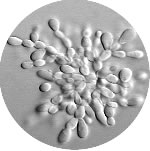Candida glabrata
- Organism Specific Information
- Concatenate Sequences
- Download Alleles
- Draw tree using own MLST data
- Download ST’s
- Compare profile to refset
- C.glabrata Links
- eBURST V3
- Contact Curator
Candida glabrata is yeast-like fungi of the species Candida, formerly known as Torulopsis glabrata. Until recently, Candida glabrata was considered a non-pathogenic saprophyte, present in the normal flora of a healthy person – they can be found on the skin, in urine. With an increase in the population of immunocompetent individuals, Candida glabrata became an opportunistic (developing with a decrease in immunity) pathogen of the urogenital tract and bloodstream (candidaemia). The main reason for the decrease in immunological reactivity is HIV infection, the use of immunosuppressive drugs, the elderly patient, uncontrolled diabetes mellitus, malignant neoplasms, leukemia.
Candida glabrata is the second pathogen in the genus Candida in prevalence after Candida albicans. Candida glabrata is difficult to treat – in 20% of cases, fungi are resistant to antifungal drugs of the azole series, which are the gold standard in the treatment of candidiasis. This is especially true for fluconazole and ketoconazole.
Candida glabrata is associated with diseases of the oral mucosa and esophagus – about 20% of cases of thrush of the mucosa are caused by this pathogen. From 10 to 33% of cases of vulvovaginal candidiasis are provoked not by the most common Candida albicans but by Candida glabrata and other Candida fungi. Urinary candidiasis caused by Candida glabrata is considered a hospital infection (nosocomial).
A systemic infection of the bloodstream, Candida glabrata candidaemia, is a serious illness with a mortality rate of 50% in people suffering from malignant diseases and 100% in bone marrow recipients.
Polymerase chain reaction allows pathologists to detect the presence of the bacteria in the body and determine the number of DNA molecules of the yeast-like fungi Candida glabrata, candidiasis pathogens.


